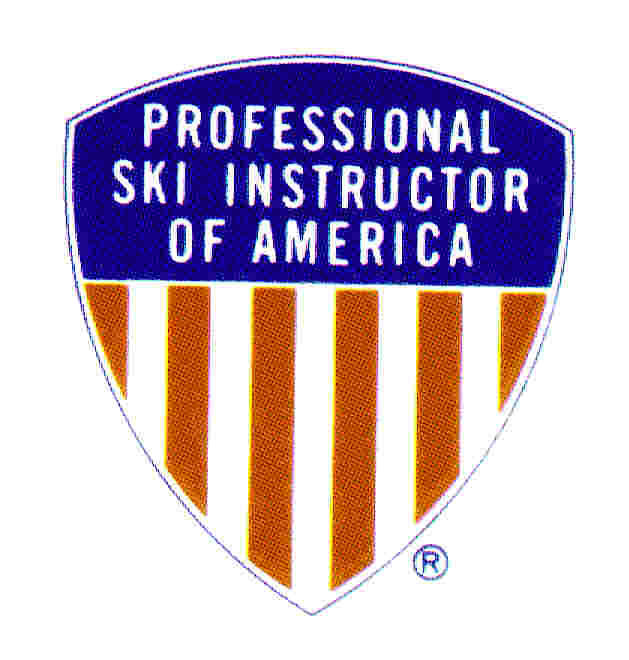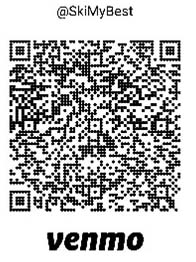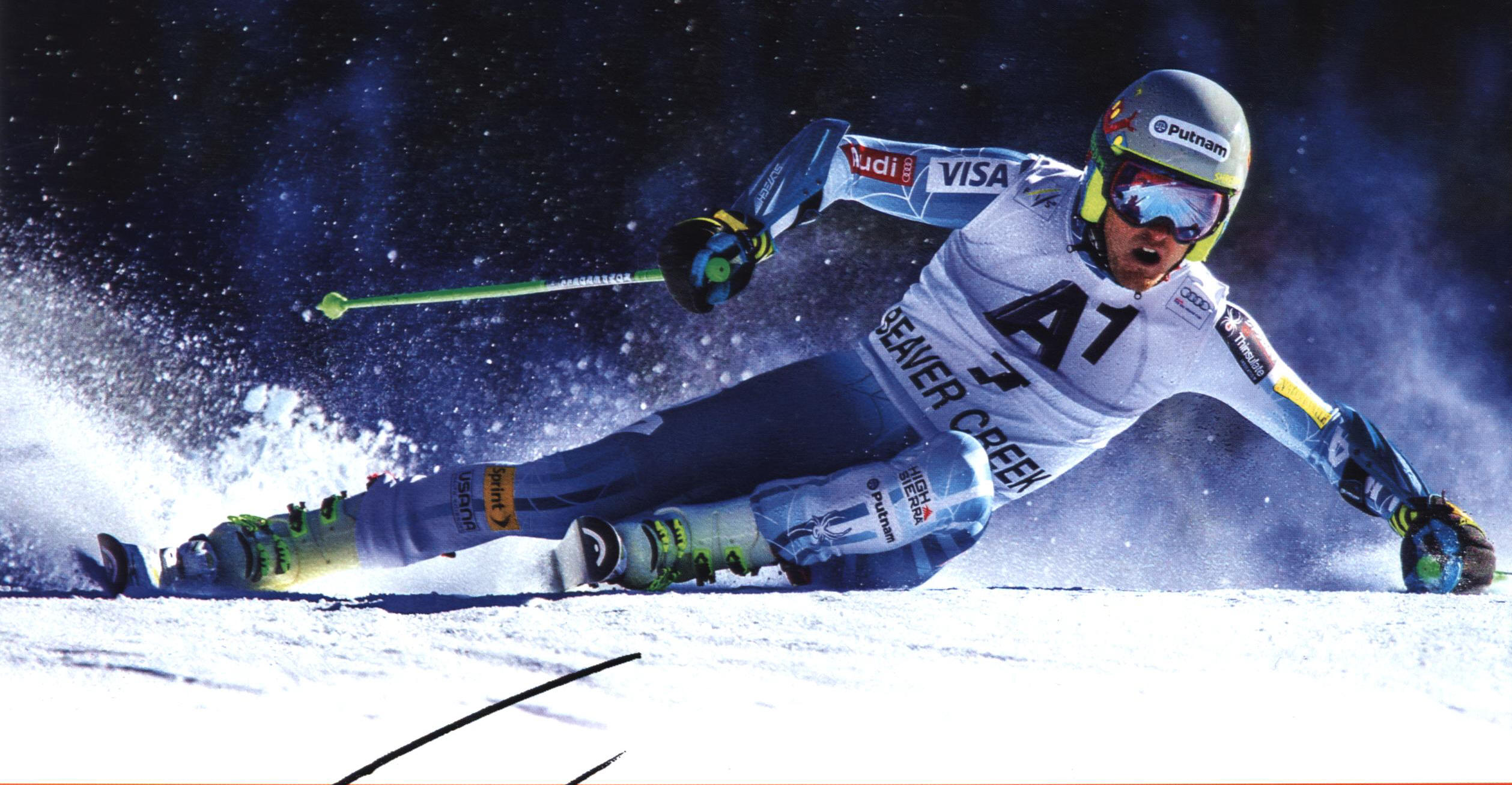|

Has
"Ski My Best" been of use? Help keep it going:

| |
Did you come here from a link on another website? See page bottom for latest version of this page.
This site is not associated with any ski area. Use of any page
means you accept the SkiMyBest Site Use
Agreement or
EXIT NOW.
 "SKIING IS A SLIDING SPORT": a skiing web manual Glossary
"SKIING IS A SLIDING SPORT": a skiing web manual Glossary
by Bill Jones, Ski Instructor
Certified Professional Ski Instructor
(Registration #110478), Level III
How To Reserve Private Ski Lessons with Bill Jones
This "Skiing Manual--Skiing is a Sliding Sport" advocates a
certain way of positioning oneself on skis and of moving one's body around that
flexible position, i.e., of maneuvering while sliding. A lot of terms are used
in describing this, and so a glossary is given in case any are not clear, for
how will you know if you are performing the moves appropriately if you don't
clearly understand the terms describing them?
A glossary is being added to this website. Meanwhile, the
following references are suggested:
THE COMPLETE ENCYCLOPEDIA OF SKIING: the indispensable
reference for instructors and all skiers, by Bob Barnes. Snowline
Press: Silverthorne, CO. 1999, 324 pages of extended definitions. ISBN
0-9669131-5-9.
CORE CONCEPTS FOR SNOWSPORTS INSTRUCTORS. Professional
Ski Instructors of America: Lakewood, CO, 2001. 90 pages. Includes
glossary.
ALPINE TECHNICAL MANUAL: Skiing and Teaching Skills.
Professional Ski Instructors of America: Lakewood, CO, 2002. 76 pages.
Includes glossary.
Words to include in glossary:
piste/off-piste: The piste is the main area of ski runs,
often groomed. The off-piste is wild snow.
graupel: snow that is more like pellets, sometimes called tapioco snow.
An early stage in the development of hail from a thunderstorm cloud, so beware
that lightning may follow soon.
inclination: the skier's whole body is tilted, causing the ski to be
tipped so the edges engage the snow more. Useful in high-speed turns so the
skeleton bones are used for support instead of over-stressing the muscles and
joints.
angulation: the skier's spine is at a different angle than the legs,
causing the ski to be tipped so the edges engage more, but without the skier
inclining as much as the legs, thus enabling a quicker entry to the next turn. A variable quantity,
may be used in conjunction with inclination. (cover of Skiing History,
Sep-Oct 2015)
anticipation: the angulated skier has already turned his torso toward the
center of the new turn; his legs are yet to do so.
banking: same as inclination.
blocking: In a turn a rotational force develops that can be blocked by a
pole plant or an edge set. This allows some rebound from the skis acted as a
spring, helping propel the skier into a new turn.
boot-out: If a skier tips so much that his boot's sides drag on the snow,
friction from that adds to the forces to be managed, often with negative result.
Boot-out cannot generally happen for recreational skiers, for they can't/don't
tip that much. A wide boot on a narrow ski would boot-out sooner. But now see
the photo of Ted Ligety, who in this scene has four points of contact with the
snow (outside ski, inside boot, seat, fist). Photo from back cover Ski, January 2016.
wedge/snowplow: a basic skiing maneuver in which the skis are posited by
the skier with tips close and tails apart, causing inside ski edges to scrape
the snow and thereby slow the skier. Snow slope, snow type, skier anatomy, and
desired speed or braking are factors that determine the width apart of the skis'
tails. A defensive ski maneuver, used mainly for slow speeds and tight spots.
Often taught to beginners as a platform to develop skills for far more effective
parallel skiing.
braking wedge: a wedge that is wide at the skis' tails.
gliding wedge: a wedge that is narrow at the skis' tails.
christie: the classic definition is that of a ski turn in which the skis
are parallel throughout but skid on their uphill edges. Short for Christiania,
former name of Oslo, Norway, where the turn was invented. Some now use the term
for a carved turn, so consider the context of use.
wedge christie: A christie (classic) that starts from the wedge position
and finishes with the skis parallel. The wedge can be closed at various points
of the turn, with sooner closings indicating more advanced skiing for higher
speeds and/or steeper slopes.
stem christie: A christie (classic) that starts with only the uphill
ski's tail displaced uphill from the other ski. Useful in situations where it is
desirable to engage the snow more with the downhill ski as a platform for the
turn to begin, as in doubtful snow conditions or in learning to ski parallel for
some who hesitate at moving the body across both skis at once. With the stem
christie that move can be done in two steps.
parallel christie: A christie (classic) in which the skis are parallel
throughout and dragging on corresponding edges (both dragging on the downhill
edges, for instance). Skidding of the skis is expected. An excellent way of
scrubbing speed from friction as well as from the turn's change of direction.
telemark turn: A turn done on skis that have bindings allowing the ski
boots' heels to be raised from the ski. Done the opposite from a turn on alpine
skis, the outside ski is advanced into the new turn first, creating an angle
with the uphill ski whose tail moves outward. The name is from the Telemark
region of Norway, where the turn was invented.
retraction: A movement in which the legs are brought upward toward the
torso. Useful in bumps, powders, and some racing situations.
extension: A movement in which the torso is moved upward from the legs.
For this to happen the legs must initially have been bent--much as in
preparation for a jump from a flat floor.
camber: A change in curve on a ski. The sides of skis are usually not
straight, but wider at the tips and tails than at the waist. The bottoms of skis
are usually not straight, either: held together, tips and tails of skis normally
touch although the waists do not. This is classic base camber. Reverse base
camber is when the waists touch but the tips and tails do not.
sidecut: The amount of deviation of the ski's sides from a straight line.
rotation: Turning the upper body in the direction of the new turn to
cause the skis to turn also. Note that to do this an "anchor" is needed else the
lower body will also turn, as in the air. For instance, one cannot change
direction once detached from earth even though one can twist the body and
gravity can produce an arc in the vertical plane. To rotate on skis, thus, one
has to engage edges or create enough skidding friction to grip the snow. This
concept may seem elusive as we are used to always being anchored on floors or
ground where we always have the feet secured.
sequential/concurrent: Legs, arms, etc. can be moved at the same time
(concurrent) or one after the other (sequential). Each method is used in
different ski maneuvers.:
shaped skis: Skis that have more sidecut than was formerly used. Also
called parabolic, new, modern, etc. The amount of shape can be varied in
manufacture to produce turns of differing radiuses.
sidestep: With skis parallel, moving one ski at a time with bases tipped
so at least one edge is always engaged--to go uphill or downhill.
sideslip: With skis parallel, tipping the ski's bases into angles nearer
the snow slope so that the skis slip downhill. In the flatter positions, skis
slip faster. Edges will scrape.
slip: A scraping of ski edges against the snow. Produced by tipping the
skis at angles nearer the snow slope.
skid: A slip while in a turn. Could be more or less depending on
angle of ski's base to snow slope. Can be used to reduce speed.
carve: A turn in which the skis do not skid. Skis are tipped sot hat
edges remain engaged throughout and parallel lines are left in the snow. This
retains the most speed in a turn but does not produce the tightest turn, which
requires skidding. It does produce delightful sensations.
arc: a curve
skate: Moving forward by stepping off a slightly tipped ski to move one
ski ahead of the other with its tip pointed outward from the body, lunging
forward and then stepping the other ski ahead the same way. Same as roller
skating or ice skating.
snow: There are many types of this white stuff:--powder, packed powder,
corn, crud, wind-crust, cement, ice
steering: Turning the legs and therefore the skis so they point a new
direction. Also, applying a force to keep the feet better aligned with the skis
even though the force does not cause a direction change. Can be done by using
the torso to work off or by using skis with partly engaged edges
stem: Moving one or both skis so the tips remain close while the tails
are apart. Typically produces friction that can slow or be used to deflect one
into a new turn.
step: Picking one ski up and moving it forward, sideways, or back, then
placing it on the snow.
tactics: Selection of ski maneuvers for particular situations or
conditions.
technique: how we ski.
traverse: skiing across a slope at a slight descent, typically with skis
parallel.
weight transfer: shifting weight from one ski to the other, done partly
or wholly.
unweighting: upward movement which when stalled by the skier causes
momentarily lightening on the skis. Think of a jump that does not leave the
ground.
mogul: a bump on a ski slope, caused by skiers making turns in the same
places. Requires adaptaion of parallel skiing technique.
chicken-heads: Short frozen columns on a ski surface that can catch a ski
and trip its rider. Occurs rarely in spring.
death-cookies: Round frozen columns on a ski surface that can catch a ski
and trip its rider. Occurs rarely in spring.
triangular sustentation: Planting a ski pole downhill with a blocking
action and in a pattern that produces a triangle among the pole and the ski
boots, creating a stable platform from which rotation can produce a turn. Useful
in difficult snow situations.
leverage: Tipping the body against the ski boots and bindings so that
more or less weight is placed fore and aft. More commonly applied aft.
parallel: Skis, ski tracks, etc., that are the same distance apart. The
tracks may be in arcs as they are on railroad lines.
hop turn: A turn down during a leap into the air. To apply the needed
rotation, the leap must occur from skis that have a purchase on the snow.
crossover/crossunder: Crossover is movement of the torso across the skis,
typically from the uphill side to the downhill side; or the reverse, crossunder
is movement of the legs under the body and across the skis, with the torso
following.
anticipation/release: Turning the upper body toward the new turn before
the legs and skis. To do this, the skis must have sufficient grip on the snow to
apply the needed force and/or the ski pole has to be planted firmly with
tension to block the rotational force. Then with the built-up muscle tension,
the skier relaxes as the skis flatten so the stored force propels the legs and
skis around. Useful as a defensive maneuver, especially in moguls to alter line.
Also produces short-radius turns.
blocking: Creating a stopping force to slow or end the rotation of the body that
occurs during a turn. Done by engaging skis's edges of with a tensed pole plant.
cant: No-no word for skiers aspiring to new challenges. Also the tipping
of ski boot soles at angles to the skis by removing some of the sole or placing
wedges under the boots. Too, just the upper part of a ski boot may have
adjusters to change its angle with the lower.
decamber/reverse camber: A ski with a base that arcs like a bow (as in
bow and arrow). Can be made that way or get de-cambered by hard landings. Useful
in softer snow conditions or when desiring quick turns
diverging/converging/parallel: Ski positions in which, respectiely, the
ski tips point outward, inward, or are the same distance apart as the tails.
drill/bag of tricks: Exercises designed to discover or sharpen particular
ski skills so they can be applied to skiing.
down stem/upstem: Displacing (Stemming) either the downhill or uphill ski
as a turn is begun.
edging/tipping/exercises.
flexion: Bending the legs at the knee to lower the torso.
fall line/gravity zone/rise line/: The fall line or gravity zone is the
most direct line down a snow slope, the course which water will follow. The rise
line goes the opposite way, up the slope.
spill zone: What direction you would fall and how far you would slide.
Spill zone depends on if stopped before falling, if skiing and how fast, where in
turn fall occurs, slickness of snow surface, steepness of snow slope. Concept
encourages consideration of location of other skiers, trees, etc., while
choosing tactics, speed, etc.
footbed: An inner sole that slips into a ski boot to hold the foot and
ankle consistently in position. It overcomes the tendency of the foot to tip
sideways from the leg at the ankle joint and thus makes edging of the ski more
precise.
alignment: Adjusting ski boots to get the leg and ankle joints in a
position of maximum range of motion and maximum strength. Involves canting of
ski boot soles and tipping of boot cuffs to best match natural angle of one's
legs (if bow-legged, knock-kneed, etc.). Includes use of footbeds.
garlands: a ski exercise involving tipping and un-tipping of skis to
produce zones of slipping and lines of traversing. This produces a garland track
in the snow. Doing garlands primarily teaches the edging skill, but is also used
in skiing to deftly move downslope or across the slope to avoid obstacles or
take advantage of snow, changing line but not turning.
falling leaf: Descent of snow slope by side-slipping alternately forward
and backward using a combination of tipping/untipping skis and leveraging fore
and aft. Excellent exercise for learning skiers and now also used for learning
snowboarders.
gliding: Skiing in a way that maximizes the use of gravity and ski shape
in creating turns.
herringbone: Method of climbing hill by taking steps from tipped skis,
one at a time. Track left in snow resembles fish skeleton.
hockey stop: Quickly pivoting the skis with the legs under the torso from
skis flat to the snow slope so the skis begin slipping perpendicular to the
body's direction of travel. As friction develops from this and slows the skis,
the skier balances against this force by leaning uphill. Practice teaches the
appropriate amount of lean for a given slipping force, the force of which
depends on snow slope, speed, ski maintenance, anatomy, snow type, and quickness
of pivot. An important skill used to slow or stop. Same as used in ice hockey.
Kids tend to pick it up quickly; adults struggle learning it. Before the era of
shaped skis, it was easier to learn because skis slipped and skidded more.
pivot slip
matching: Moving one or both skis into a parallel situation after being
stemmed.
pivoting/steering
stance/balance
railroad tracks: Parallel ski lines in the snow, produced in carved
turns where ski design and tipping cause the turn rather than a rotational
force.
open-stance parallel: Skis are parallel throughout turn but wider apart than
usual. Provides stability but can lead to skiing on inside edges if too wide.
albedo: Reflectivity of the snow surface. More light is reflected from
new snow when the crystal edges are still sharp. Wear sunscreen and sunglasses
then, especially.
replemont
avelemont = swallowing or retraction
some more from skismart.com (see for definitions)
balancing
cants
carving
center of mass
counter-rotation
edge agnle
flow line
flexion
garland
inclination
matching skis
pressure control
rebounding
retraction
side-slipping
skidding
sweet spot
traversing
steering
muscle-memory
 "SKIING
IS A SLIDING SPORT"--a skiing web manual: Skiing
Web
Manual Contents
Why Read This Skiing Web Manual
That First Skiing Lesson
A Little Skiing History Motion
in Skiing
Conventional Skiing Wisdoms
Skier Excuses
Fear in Skiing
Conditioning for Skiing
Equipment and Technique Skiing
Equipment
How Skis
Work How
to Develop Balance on Skis
A Skiing Turn
Simplified
The Final Skiing Skill: pressure management
Tactics for Terrains and Snow Textures and Racing
Skiing Tips and
Tales--a potpourri Exercises for
Developing Skiing Skills
Children and Skiing
Age and Skiing
Gender & Skiing
Culture & Skiing Skiing Ethics
and Slope Survival Slope Safety
Skiing Environment Videos and Apps
GLOSSARY
Acknowledgements
SkiMyBest Website Contents "SKIING
IS A SLIDING SPORT"--a skiing web manual: Skiing
Web
Manual Contents
Why Read This Skiing Web Manual
That First Skiing Lesson
A Little Skiing History Motion
in Skiing
Conventional Skiing Wisdoms
Skier Excuses
Fear in Skiing
Conditioning for Skiing
Equipment and Technique Skiing
Equipment
How Skis
Work How
to Develop Balance on Skis
A Skiing Turn
Simplified
The Final Skiing Skill: pressure management
Tactics for Terrains and Snow Textures and Racing
Skiing Tips and
Tales--a potpourri Exercises for
Developing Skiing Skills
Children and Skiing
Age and Skiing
Gender & Skiing
Culture & Skiing Skiing Ethics
and Slope Survival Slope Safety
Skiing Environment Videos and Apps
GLOSSARY
Acknowledgements
SkiMyBest Website Contents
This "Glossary" page
last modified
January 9, 2023. Did you come here from a link on another website?
For latest version of this page, copy to your browser: http://www.SkiMyBest.com/skigloss.htm.
Copyright © 2013, 2014, 2015, 2016, 2017, 2018, 2019, 2020, 2021, 2022. William R Jones.
| |

|
 "SKIING
IS A SLIDING SPORT"--a skiing web manual: Skiing
Web
Manual Contents
Why Read This Skiing Web Manual
That First Skiing Lesson
A Little Skiing History Motion
in Skiing
Conventional Skiing Wisdoms
Skier Excuses
Fear in Skiing
Conditioning for Skiing
Equipment and Technique Skiing
Equipment
How Skis
Work How
to Develop Balance on Skis
A Skiing Turn
Simplified
The Final Skiing Skill: pressure management
Tactics for Terrains and Snow Textures and Racing
Skiing Tips and
Tales--a potpourri Exercises for
Developing Skiing Skills
Children and Skiing
Age and Skiing
Gender & Skiing
Culture & Skiing Skiing Ethics
and Slope Survival Slope Safety
Skiing Environment Videos and Apps
GLOSSARY
Acknowledgements
SkiMyBest Website Contents
"SKIING
IS A SLIDING SPORT"--a skiing web manual: Skiing
Web
Manual Contents
Why Read This Skiing Web Manual
That First Skiing Lesson
A Little Skiing History Motion
in Skiing
Conventional Skiing Wisdoms
Skier Excuses
Fear in Skiing
Conditioning for Skiing
Equipment and Technique Skiing
Equipment
How Skis
Work How
to Develop Balance on Skis
A Skiing Turn
Simplified
The Final Skiing Skill: pressure management
Tactics for Terrains and Snow Textures and Racing
Skiing Tips and
Tales--a potpourri Exercises for
Developing Skiing Skills
Children and Skiing
Age and Skiing
Gender & Skiing
Culture & Skiing Skiing Ethics
and Slope Survival Slope Safety
Skiing Environment Videos and Apps
GLOSSARY
Acknowledgements
SkiMyBest Website Contents